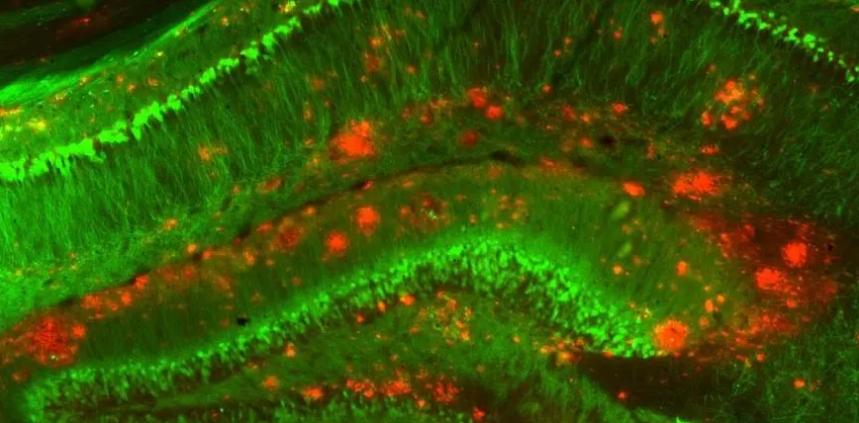
研究人员已经成功设计出一种抗体,其能够识别破坏健康脑细胞的有毒微粒——这是对抗阿尔茨海默氏症的潜在进步。
Researchers have found a way to design an antibody that can identify the toxic particles that destroy healthy brain cells – a potential advance in the fight against Alzheimer’s disease.
他们的方法能够识别这些被称为淀粉样β低聚物的有毒微粒,这是阿尔茨海默氏症的标志,点燃了人们通过新的诊断方法来治疗阿尔茨海默氏症和其他形式痴呆症的希望。
Their method is able to recognise these toxic particles, known as amyloid-beta oligomers, which are the hallmark of the disease, leading to hope that new diagnostic methods can be developed for Alzheimer’s disease and other forms of dementia.
来自剑桥大学、伦敦大学学院和隆德大学的研究小组设计了一种抗体,这种抗体在检测有毒低聚物和量化其数量方面具有很高的准确性。他们的研究结果发表在《美国国家科学院院刊》(PNAS)上。
The team, from the University of Cambridge, University College London and Lund University, designed an antibody which is highly accurate at detecting toxic oligomers and quantifying their numbers. Their results are reported in the Proceedings of the National Academy of Sciences (PNAS).
领导这项研究的剑桥大学错叠疾病研究中心的米歇尔·温鲁斯科洛教授说:“我们迫切需要定量方法来识别低聚物,这种低聚物在阿尔茨海默氏症中扮演着重要角色,但对于标准的抗体发现策略来说太难实现,通过我们创新的设计策略,我们现在已经发现了能够识别有毒微粒的抗体。”
“There is an urgent unmet need for quantitative methods to recognise oligomers – which play a major role in Alzheimer’s disease, but are too elusive for standard antibody discovery strategies,” said Professor Michele Vendruscolo from Cambridge’s Centre for Misfolding Diseases, who led the research. “Through our innovative design strategy, we have now discovered antibodies to recognise these toxic particles.”
在英国,痴呆症是导致死亡的主要原因之一,每年的花费超过260亿英镑,预计在未来25年内,这个数字将会翻倍。据估计,其目前每年造成的全球经济成本接近1万亿英镑。
Dementia is one of the leading causes of death in the UK and costs more than £26 billion each year, a figure which is expected to more than double in the next 25 years. Estimates put the current cost to the global economy at nearly £1 trillion per year.
阿尔茨海默氏症是痴呆症中最常见的一种,它会引发大脑中神经细胞和组织的死亡,导致记忆衰退、性格改变和生活能力下降。
Alzheimer’s disease, the most prevalent form of dementia, leads to the death of nerve cells and tissue loss throughout the brain, resulting in memory failure, personality changes and problems carrying out daily activities.
科学家们已经发现,一种叫做低聚物的异常蛋白质团块是最有可能导致痴呆的原因。根据淀粉样蛋白假说,尽管蛋白质通常负责重要的细胞过程,但当人们患有阿尔茨海默氏症时,这些蛋白质-特别是淀粉样蛋白-会失控并杀死健康的神经细胞。
Abnormal clumps of proteins called oligomers have been identified by scientists as the most likely cause of dementia. Although proteins are normally responsible for important cell processes, according to the amyloid hypothesis, when people have Alzheimer’s disease these proteins –including specifically amyloid-beta proteins – become rogue and kill healthy nerve cells.
蛋白质需要密切调节才能正常发挥作用。当这种质量控制过程失败时,蛋白质就会发生错误折叠,引发连锁反应,导致脑细胞死亡。错误折叠的蛋白质形成了一种叫做斑块的异常簇,它在脑细胞之间堆积,阻止了脑细胞正常地发出信号。死亡的脑细胞还含有缠结,扭曲的蛋白质链,破坏了重要的细胞运输系统,这意味着营养和其它基本供应无法再通过细胞传输。
Proteins need to be closely regulated to function properly. When this quality control process fails, the proteins misfold, starting a chain reaction that leads to the death of brain cells. Misfolded proteins form abnormal clusters called plaques which build up between brain cells, stopping them from signalling properly. Dying brain cells also contain tangles, twisted strands of proteins that destroy a vital cell transport system, meaning nutrients and other essential supplies can no longer move through the cells.
阿尔茨海默氏症已经有超过400个临床试验,但是尚未有可以改变阿尔茨海默氏症病程的药物获批。在英国,痴呆症是排名前十的死亡原因中唯一没有得到预防、阻止或减缓其进展的疾病。
There have been over 400 clinical trials for Alzheimer’s disease, but no drug that can modify the course of the disease has been approved. In the UK, dementia is the only condition in the top 10 causes of death without a treatment to prevent, stop, or slow its progression.
温鲁斯科洛说:“虽然淀粉样蛋白假说是一种普遍的观点,但它还没有完全得到证实,部分原因是淀粉样蛋白-低聚物很难被检测到,因此对于阿尔茨海默病的病因尚存不同的看法。所以发现一种能够精确靶向低聚体的抗体是监测疾病进展、确定病因并最终控制病情的重要一步。”
“While the amyloid hypothesis is a prevalent view, it has not been fully validated in part because amyloid-beta oligomers are so difficult to detect, so there are differing opinions on what causes Alzheimer’s disease,” said Vendruscolo. “The discovery of an antibody to accurately target oligomers is, therefore, an important step to monitor the progression of the disease, identify its cause, and eventually keep it under control.”
缺乏检测低聚物的方法一直是研究阿尔茨海默病的主要障碍。这阻碍了有效诊断和治疗干预的发展,并导致淀粉样蛋白假说的不确定性。
The lack of methods to detect oligomers has been a major obstacle in the progress of Alzheimer’s research. This has hampered the development of effective diagnostic and therapeutic interventions and led to uncertainty about the amyloid hypothesis.
该研究的第一作者弗朗西斯科·阿普瑞博士说:“低聚物很难检测、分离和研究,我们的方法允许生成抗体分子,尽管它们具有异质性,但仍能靶向低聚物,我们希望这能成为新的诊断方法的重要一步。”
“Oligomers are difficult to detect, isolate, and study,” said Dr Francesco Aprile, the study’s first author. “Our method allows the generation of antibody molecules able to target oligomers despite their heterogeneity, and we hope it could be a significant step towards new diagnostic approaches.”
该方法基于过去十年在错叠疾病中心开发的抗体发现方法。基于抗体-抗原的计算组装,该方法能够为具有高度挑战性的抗原设计抗体,例如那些只能存活很短时间的抗原。
The method is based on an approach for antibody discovery developed over the last ten years at the Centre for Misfolding Diseases. Based on the computational assembly of antibody-antigen assemblies, the method enables the design of antibodies for antigens that are highly challenging, such as those that live only for a very short time.
通过使用能够靶向低聚物的特定区域或表位的合理设计策略,以及广泛的体外和体内实验,研究人员设计了一种对低聚物的亲和力至少比其他形式的β淀粉样蛋白高三个数量级的抗体,这种差异是使抗体能够在体外和体内样品中明确量化低聚物的关键特征。
By using a rational design strategy that enables to target specific regions, or epitopes, of the oligomers, and a wide range of in vitro and in vivo experiments, the researchers have designed an antibody with at least three orders of magnitude greater affinity for the oligomers over other forms of amyloid-beta. This difference is the key feature that enables the antibody to specifically quantify oligomers in both in vitro and in vivo samples.
研究小组希望这一工具将有助于发现更好的候选药物,并为患者设计更好的临床试验。他们还共同创立了Wren Therapeutics,这是一家在健康化学孵化器中的衍生生物技术公司,位于最近开放的健康化学大楼中,其使命是将剑桥大学提出的想法转化为治疗阿尔茨海默氏病和其他蛋白质折叠错误的新药。
The team hopes that this tool will enable the discovery of better drug candidates and the design of better clinical trials for people affected by the debilitating disease. They also co-founded Wren Therapeutics, a spin-out biotechnology company based at the Chemistry of Health Incubator, in the recently opened Chemistry of Health building, whose mission it is to take the ideas developed at the University of Cambridge and translate them into finding new drugs to treat Alzheimer’s disease and other protein misfolding disorders.
剑桥大学商业化部门剑桥企业已申请了该抗体的专利。
The antibody has been patented by Cambridge Enterprise, the University’s commercialisation arm.